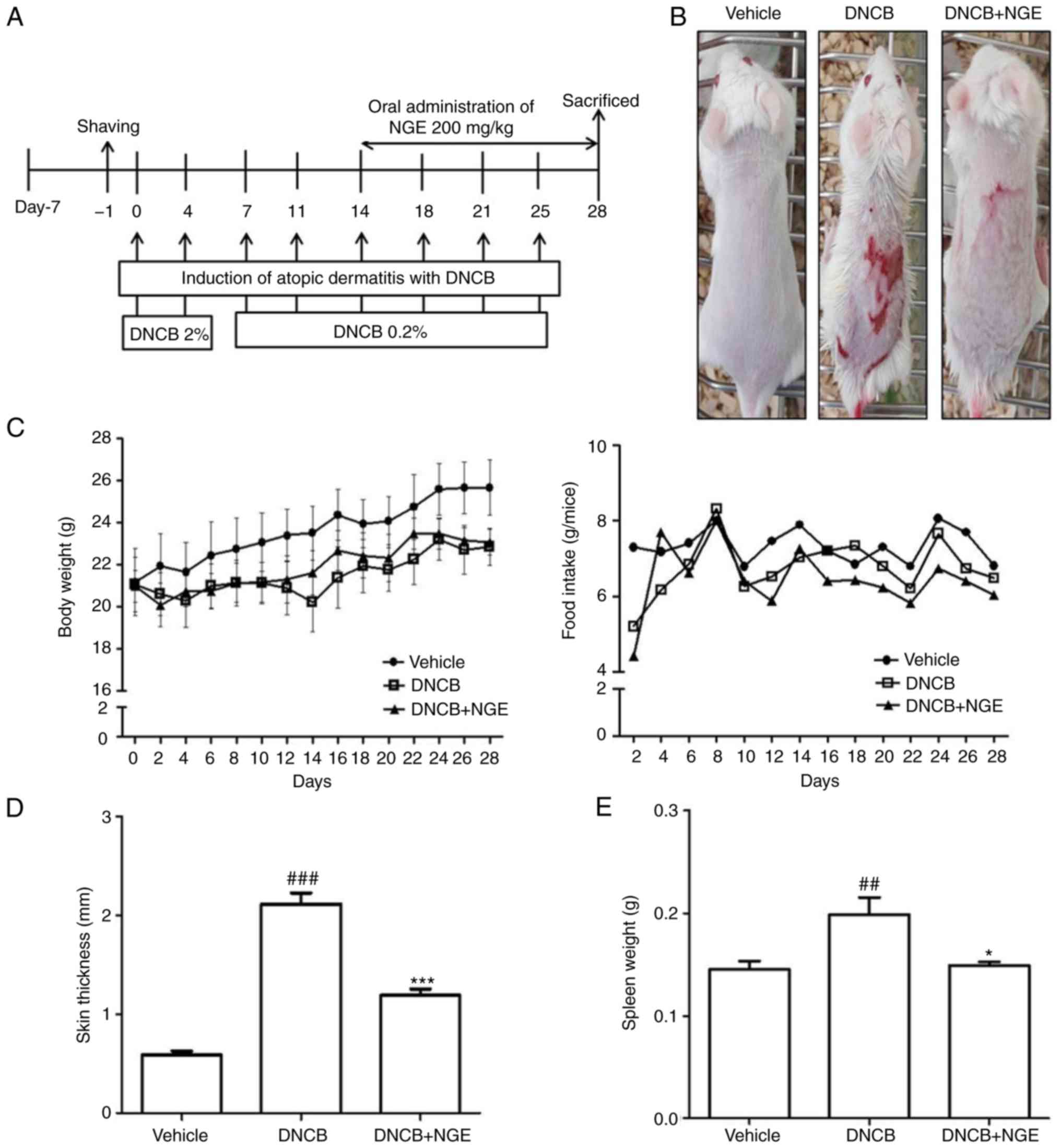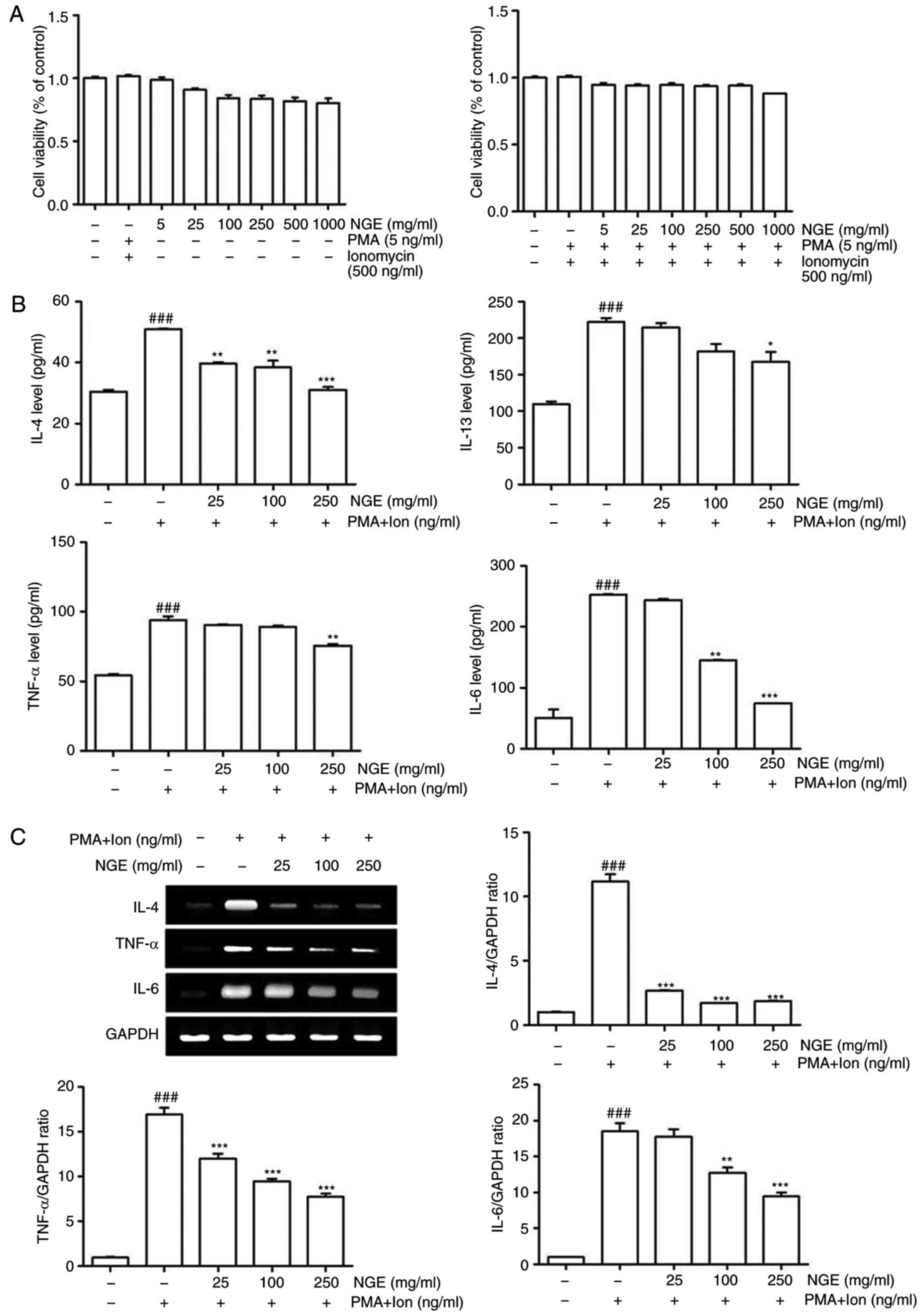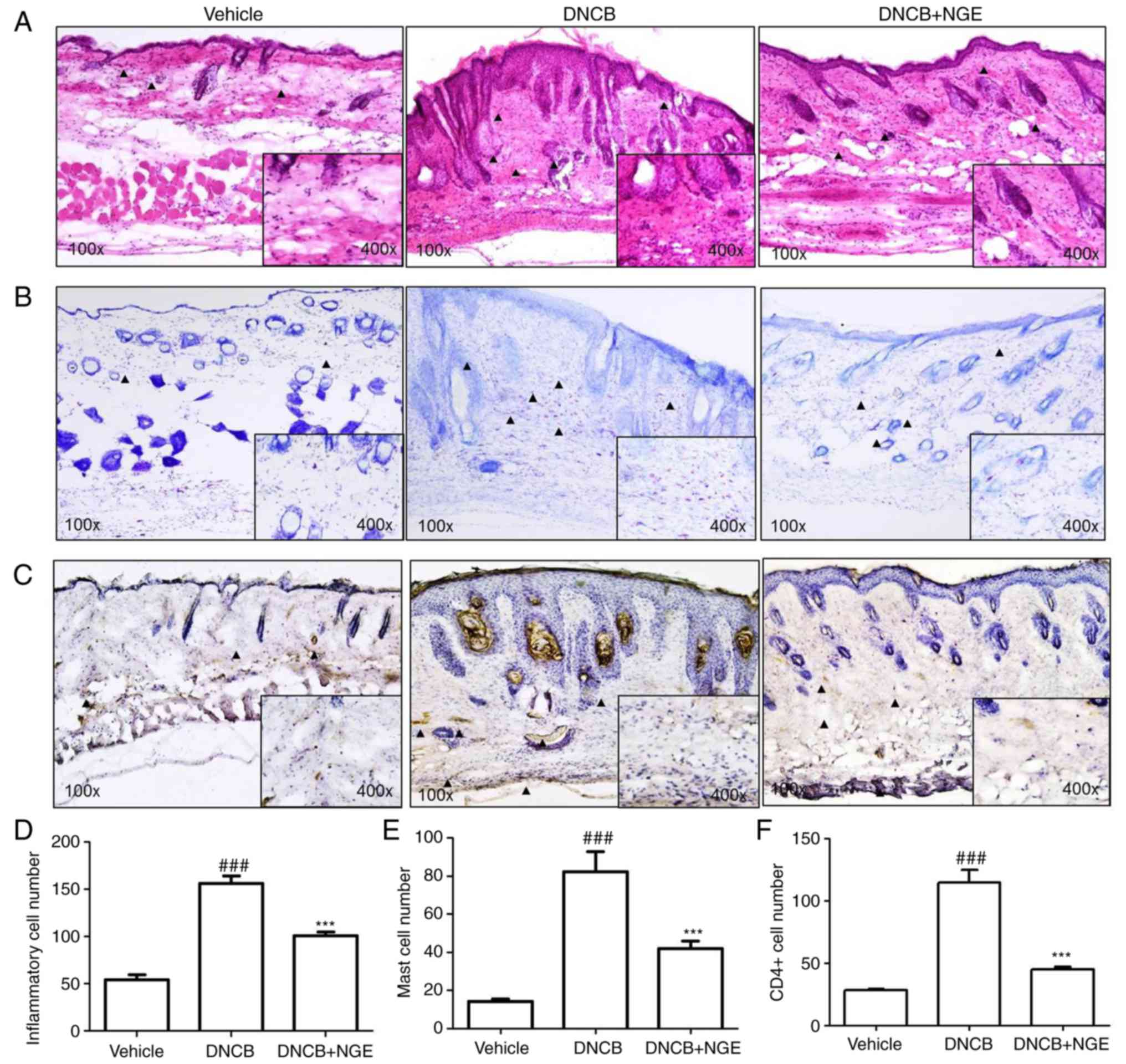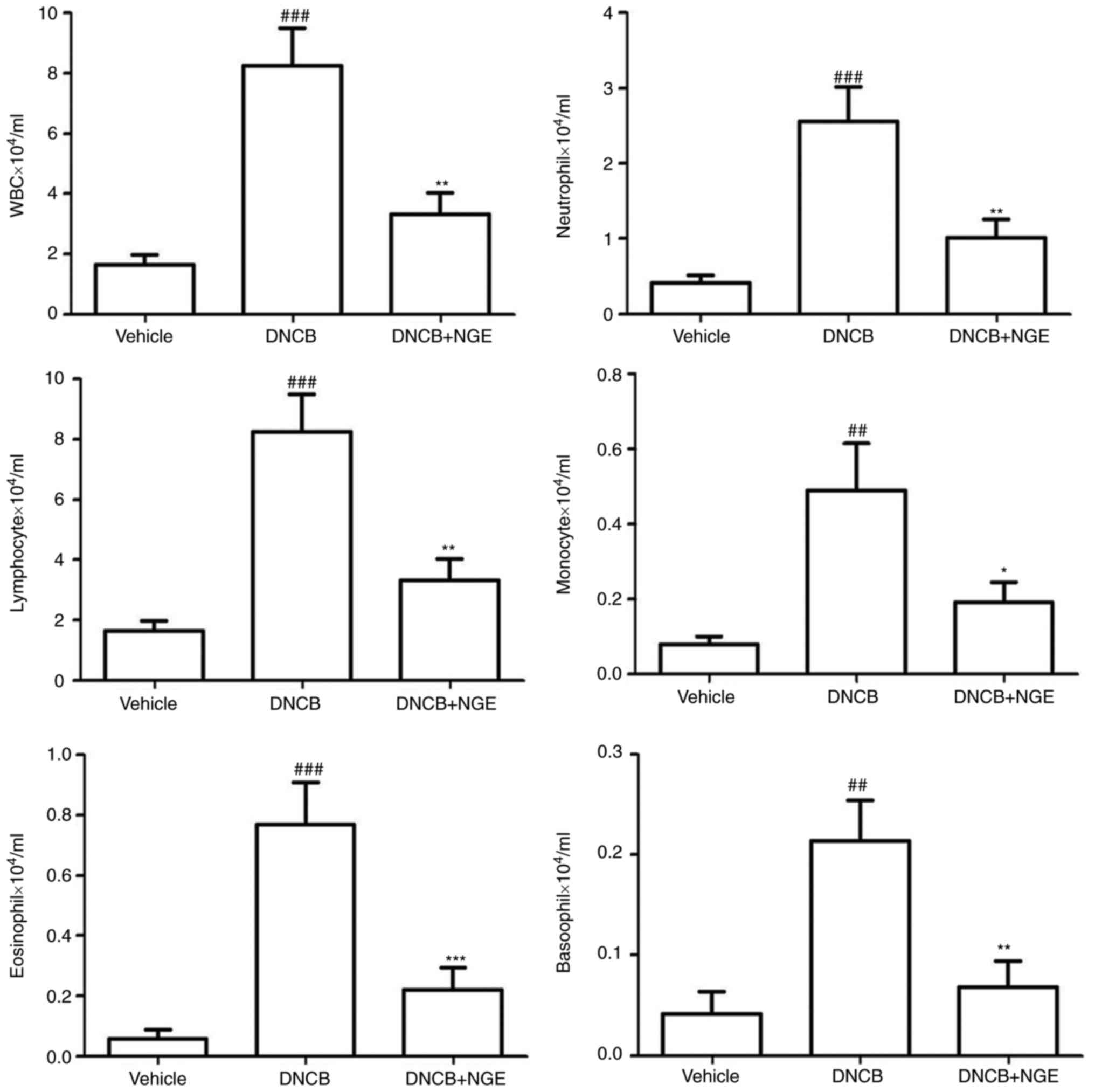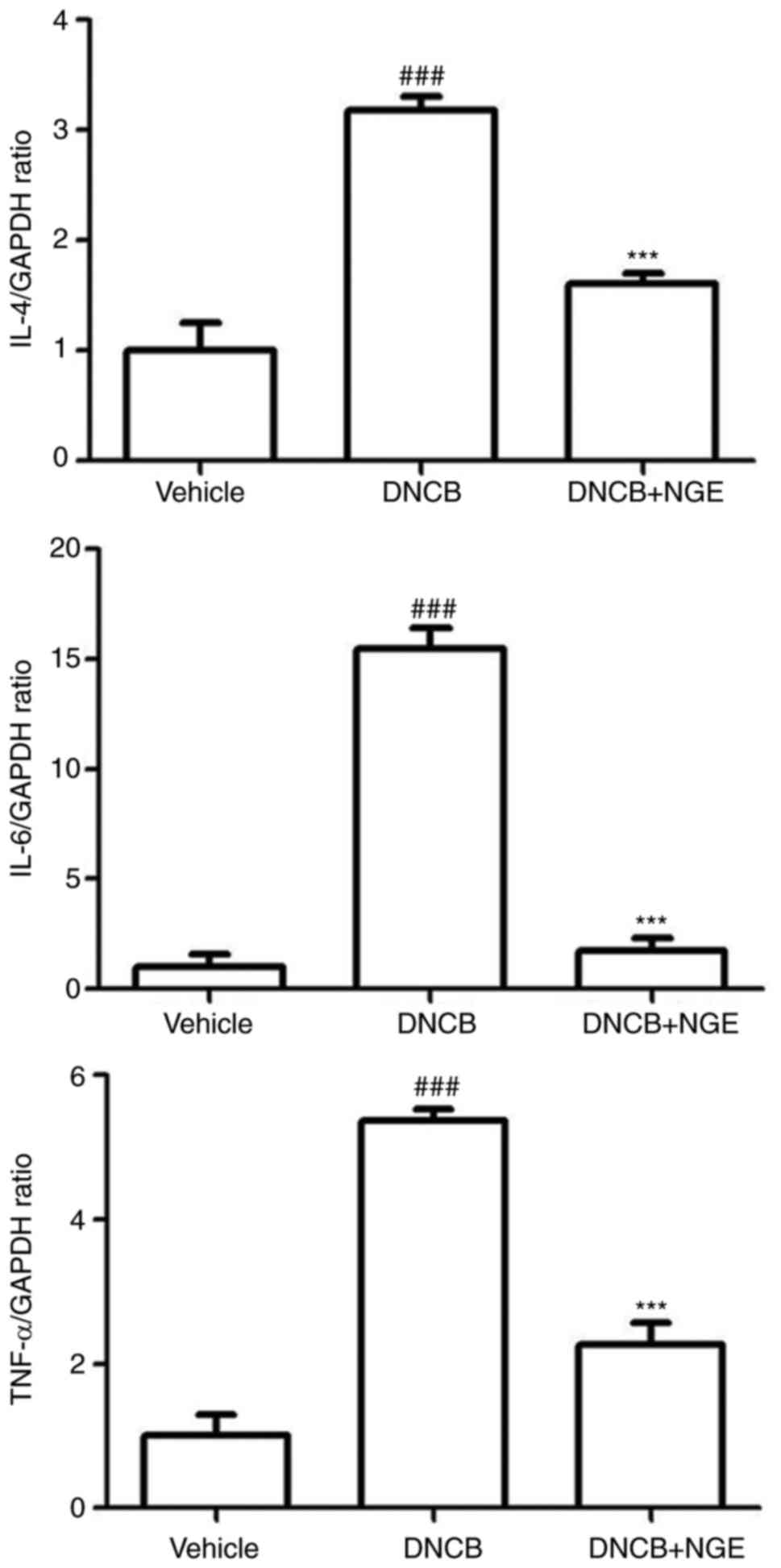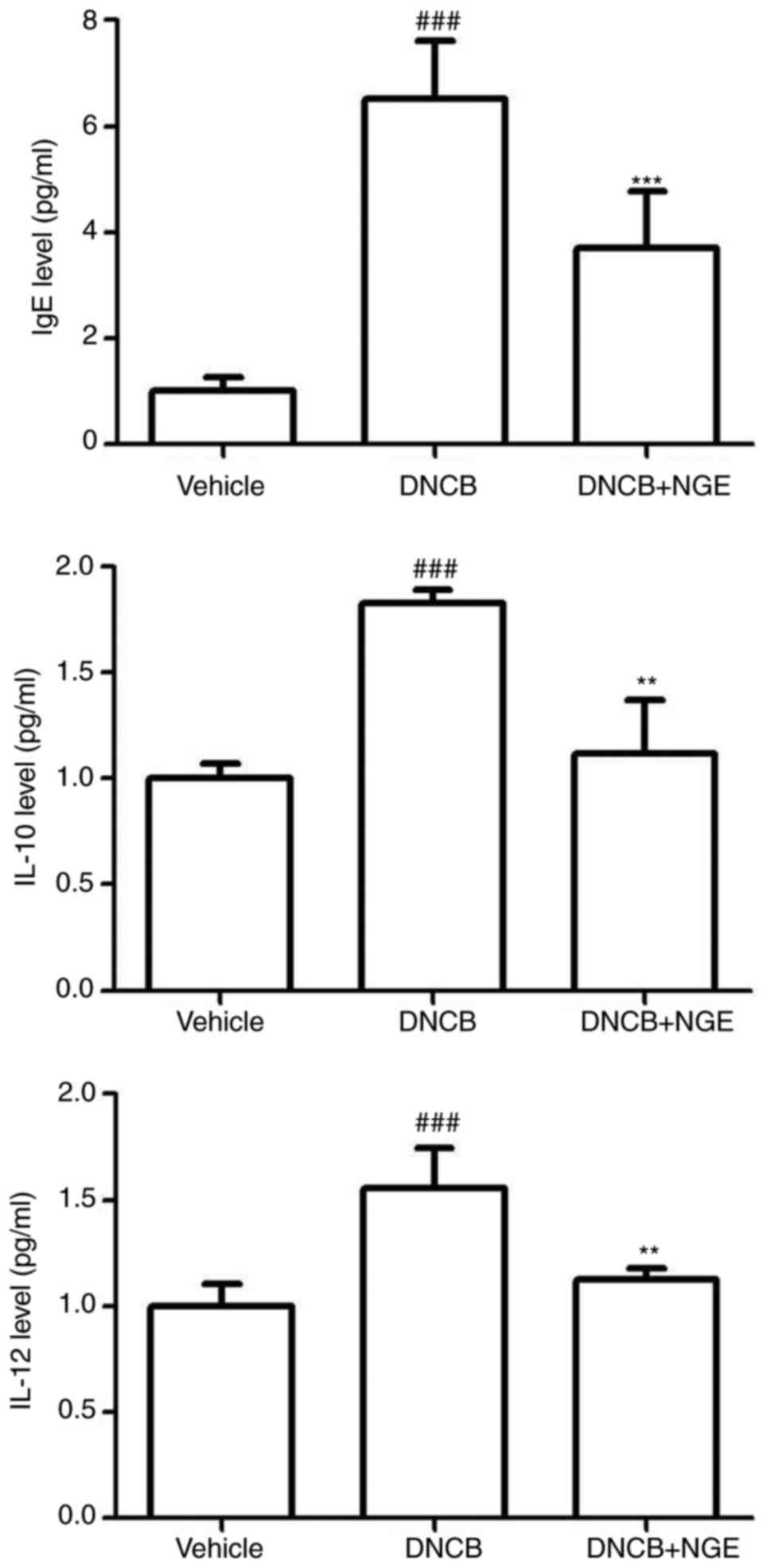|
1
|
Leung DY and Bieber T: Atopic dermatitis.
Lancet. 361:151–160. 2003. View Article : Google Scholar : PubMed/NCBI
|
|
2
|
Spergel JM and Paller AS: Atopic
dermatitis and the atopic march. J Allergy Clin Immunol.
112:S118–S127. 2003. View Article : Google Scholar : PubMed/NCBI
|
|
3
|
Simon D, Braathen LR and Simon HU:
Eosinophils and atopic dermatitis. Allergy. 59:561–570. 2004.
View Article : Google Scholar : PubMed/NCBI
|
|
4
|
Rousset F, Robert J, Andary M, Bonnin JP,
Souillet G, Chrétien I, Brière F, Pène J and de Vries JE: Shifts in
interleukin-4 and interferon-gamma production by T cells of
patients with elevated serum IgE levels and the modulatory effects
of these lymphokines on spontaneous IgE synthesis. J Allergy Clin
Immunol. 87:58–69. 1991. View Article : Google Scholar : PubMed/NCBI
|
|
5
|
Bieber T: Atopic dermatitis. Ann Dermatol.
22:125–137. 2010. View Article : Google Scholar : PubMed/NCBI
|
|
6
|
Gleich GJ: Mechanisms of
eosinophil-associated inflammation. J Allergy Clin Immunol.
105:651–663. 2000. View Article : Google Scholar : PubMed/NCBI
|
|
7
|
Holt PG, Macaubas C, Stumbles PA and Sly
PD: The role of allergy in the development of asthma. Nature.
402:B12–B17. 1999. View
Article : Google Scholar : PubMed/NCBI
|
|
8
|
Leiferman KM: Eosinophils in atopic
dermatitis. Allergy. 9:20–26. 1989. View Article : Google Scholar
|
|
9
|
Ogawa K, Hashida R, Miyagawa M, Kagaya S,
Sugita Y, Matsumoto K, Katsunuma T, Akasawa A, Tsujimoto G and
Saito H: Analysis of gene expression in peripheral blood
eosinophils from patients with atopic dermatitis and in vitro
cytokine-stimulated blood eosinophils. Clin Exp Immunol.
131:436–445. 2003. View Article : Google Scholar : PubMed/NCBI
|
|
10
|
Hanifin JM, Cooper KD, Ho VC, Kang S,
Krafchik BR, Margolis DJ, Schachner LA, Sidbury R, Whitmore SE,
Sieck CK, et al: Guidelines of care for atopic dermatitis,
developed in accordance with the American Academy of Dermatology
(AAD)/American Academy of Dermatology Association 'Administrative
Regulations for Evidence-Based Clinical Practice Guidelines'. J Am
Acad Dermatol. 50:391–404. 2004. View Article : Google Scholar : PubMed/NCBI
|
|
11
|
Novak N, Valenta R, Bohle B, Laffer S,
Haberstok J, Kraft S and Bieber T: FcepsilonRI engagement of
Langerhans cell-like dendritic cells and inflammatory dendritic
epidermal cell-like dendritic cells induces chemotactic signals and
different T-cell phenotypes in vitro. J Allergy Clin Immunol.
113:949–957. 2004. View Article : Google Scholar : PubMed/NCBI
|
|
12
|
Ong PY and Leung DY: Immune dysregulation
in atopic dermatitis. Curr Allergy Asthma Rep. 6:384–389. 2006.
View Article : Google Scholar : PubMed/NCBI
|
|
13
|
Homey B, Steinhoff M, Ruzicka T and Leung
DY: Cytokines and chemokines orchestrate atopic skin inflammation.
J Allergy Clin Immunol. 118:178–189. 2006. View Article : Google Scholar : PubMed/NCBI
|
|
14
|
Leung DY, Boguniewicz M, Howell MD, Nomura
I and Hamid QA: New insights into atopic dermatitis. J Clin Invest.
113:651–657. 2004. View
Article : Google Scholar : PubMed/NCBI
|
|
15
|
Dearman RJ, Basketter DA and Kimber I:
Differential cytokine production following chronic exposure of mice
to chemical respiratory and contact allergens. Immunology.
86:545–550. 1995.PubMed/NCBI
|
|
16
|
Dearman RJ, Basketter DA and Kimber I:
Characterization of chemical allergens as a function of divergent
cytokine secretion profiles induced in mice. Toxicol Appl
Pharmacol. 138:308–316. 1996. View Article : Google Scholar : PubMed/NCBI
|
|
17
|
Warbrick EV, Dearman RJ, Basketter DA and
Kimber I: Analysis of interleukin 12 protein production and mRNA
expression in mice exposed topically to chemical allergens.
Toxicology. 132:57–66. 1999. View Article : Google Scholar : PubMed/NCBI
|
|
18
|
Choi HS, Kim SR, Hong SH, Ku JM, Kim MK,
Seo HS, Cho SG, Shin S, Shin YC and Ko SG: Water extract of deer
bones activates macrophages and alleviates neutropenia. Evid Based
Complement Alternat Med. 2013:6173022013. View Article : Google Scholar : PubMed/NCBI
|
|
19
|
Du CN, Min AY, Kim HJ, Shin SK, Yu HN,
Sohn EJ, Ahn CW, Jung SU, Park SH and Kim MR: Deer bone extract
prevents against scopolamine-induced memory impairment in mice. J
Med Food. 18:157–165. 2015. View Article : Google Scholar :
|
|
20
|
Li YJ, Kim TH, Kwak HB, Lee ZH, Lee SY and
Jhon GJ: Chloroform extract of deer antler inhibits osteoclast
differentiation and bone resorption. J Ethnopharmacol. 113:191–198.
2007. View Article : Google Scholar : PubMed/NCBI
|
|
21
|
Kuo CY, Wang T, Dai TY, Wang CH, Chen KN,
Chen YP and Chen MJ: Effect of the velvet antler of formosan sambar
deer (Cervus unicolor swinhoei) on the prevention of an allergic
airway response in mice. Evid Based Complement Alternat Med.
2012:4813182012. View Article : Google Scholar
|
|
22
|
Dai TY, Wang CH, Chen KN, Huang IN, Hong
WS, Wang SY, Chen YP, Kuo CY and Chen MJ: The antiinfective effects
of velvet antler of formosan sambar deer (Cervus unicolor swinhoei)
on staphylococcus aureus-infected mice. Evid Based Complement
Alternat Med. 2011:5340692011. View Article : Google Scholar : PubMed/NCBI
|
|
23
|
Hong SH, Ku JM, In Kim H, Ahn CW, Park SH,
Seo HS, Shin YC and Ko SG: The immune-enhancing activity of Cervus
nippon mantchuricus extract (NGE) in RAW264.7 macrophage cells and
immunosuppressed mice. Food Res Int. 99:623–629. 2017. View Article : Google Scholar : PubMed/NCBI
|
|
24
|
Kang SK, Kim KS, Kim SI, Chung KH, Lee IS
and Kim CH: Immunosuppressive activity of deer antler extracts of
Cervus korean TEMMINCK varmantchuricus Swinhoe, on type II
collagen-induced arthritis In Vitro. Cell Dev Biol Anim.
42:100–107. 2006. View Article : Google Scholar
|
|
25
|
Kim KS, Choi YH, Kim KH, Lee YC, Kim CH,
Moon SH, Kang SG and Park YG: Protective and anti-arthritic effects
of deer antler aqua-acupuncture (DAA), inhibiting dihydroorotate
dehydrogenase, on phosphate ions-mediated chondrocyte apoptosis and
rat collagen-induced arthritis. Int Immunopharmacol. 4:963–973.
2004. View Article : Google Scholar : PubMed/NCBI
|
|
26
|
Lee H, Choi HS, Park Y, Ahn CW, Jung SU,
Park SH and Suh HJ: Effects of deer bone extract on the expression
of pro-inflammatory cytokine and cartilage-related genes in
monosodium iodoacetate-induced osteoarthritic rats. Biosci
Biotechnol Biochem. 78:1703–1709. 2014. View Article : Google Scholar : PubMed/NCBI
|
|
27
|
Galli SJ, Tsai M and Piliponsky AM: The
development of allergic inflammation. Nature. 454:445–454. 2008.
View Article : Google Scholar : PubMed/NCBI
|
|
28
|
Ku JM, Hong SH, Kim HI, Seo HS, Shin YC
and Ko SG: Effects of Angelicae dahuricae radix on
2,4-dinitrochloro-benzene-induced atopic dermatitis-like skin
lesions in mice model. BMC Complement Altern Med. 17:982017.
View Article : Google Scholar
|
|
29
|
Liu FT, Goodarzi H and Chen HY: IgE, mast
cells, and eosinophils in atopic dermatitis. Clin Rev Allergy
Immunol. 41:298–310. 2011. View Article : Google Scholar : PubMed/NCBI
|
|
30
|
Lubach D, Bensmann A and Bornemann U:
Steroid-induced dermal atrophy. Investigations on discontinuous
application. Dermatologica. 179:67–72. 1989. View Article : Google Scholar : PubMed/NCBI
|
|
31
|
Reitamo S, Rissanen J, Remitz A, Granlund
H, Erkko P, Elg P, Autio P and Lauerma AI: Tacrolimus ointment does
not affect collagen synthesis: Results of a single-center
randomized trial. J Invest Dermatol. 111:396–398. 1998. View Article : Google Scholar : PubMed/NCBI
|
|
32
|
Werfel T, Allam JP, Biedermann T, Eyerich
K, Gilles S, Guttman-Yassky E, Hoetzenecker W, Knol E, Simon HU,
Wollenberg A, et al: Cellular and molecular immunologic mechanisms
in patients with atopic dermatitis. J Allergy Clin Immunol.
138:336–349. 2016. View Article : Google Scholar : PubMed/NCBI
|
|
33
|
Kawakami T, Ando T, Kimura M, Wilson BS
and Kawakami Y: Mast cells in atopic dermatitis. Curr Opin Immunol.
21:666–678. 2009. View Article : Google Scholar : PubMed/NCBI
|
|
34
|
Metz M, Grimbaldeston MA, Nakae S,
Piliponsky AM, Tsai M and Galli SJ: Mast cells in the promotion and
limitation of chronic inflammation. Immunol Rev. 217:304–328. 2007.
View Article : Google Scholar : PubMed/NCBI
|
|
35
|
Theoharides TC, Kempuraj D, Tagen M, Conti
P and Kalogeromitros D: Differential release of mast cell mediators
and the pathogenesis of inflammation. Immunol Rev. 217:65–78. 2007.
View Article : Google Scholar : PubMed/NCBI
|
|
36
|
Kalesnikoff J and Galli SJ: New
developments in mast cell biology. Nat Immunol. 9:1215–1223. 2008.
View Article : Google Scholar : PubMed/NCBI
|
|
37
|
Miller MD, Hata S, De Waal Malefyt R and
Krangel MS: A novel polypeptide secreted by activated human T
lymphocytes. J Immunol. 143:2907–2916. 1989.PubMed/NCBI
|
|
38
|
Zipfel PF, Balke J, Irving SG, Kelly K and
Siebenlist U: Mitogenic activation of human T cells induces two
closely related genes which share structural similarities with a
new family of secreted factors. J Immunol. 142:1582–1590.
1989.PubMed/NCBI
|
|
39
|
Hamid Q, Boguniewicz M and Leung DY:
Differential in situ cytokine gene expression in acute versus
chronic atopic dermatitis. J Clin Invest. 94:870–876. 1994.
View Article : Google Scholar : PubMed/NCBI
|
|
40
|
Ahmadzadeh M, Hussain SF and Farber DL:
Heterogeneity of the memory CD4 T cell response: Persisting
effectors and resting memory T cells. J Immunol. 166:926–935. 2001.
View Article : Google Scholar : PubMed/NCBI
|
|
41
|
Hershey GK, Friedrich MF, Esswein LA,
Thomas ML and Chatila TA: The association of atopy with a
gain-of-function mutation in the alpha subunit of the interleukin-4
receptor. N Engl J Med. 337:1720–1725. 1997. View Article : Google Scholar : PubMed/NCBI
|
|
42
|
Matsumoto K and Saito H: The role of
eosinophils in asthma: Sarastro or the Queen of the Night? Int Arch
Allergy Immunol. 125:290–296. 2001. View Article : Google Scholar : PubMed/NCBI
|
|
43
|
Gottlieb AB: Therapeutic options in the
treatment of psoriasis and atopic dermatitis. J Am Acad Dermatol.
53:S3–S16. 2005. View Article : Google Scholar : PubMed/NCBI
|
|
44
|
Del Rosso J and Friedlander SF:
Corticosteroids: Options in the era of steroid-sparing therapy. J
Am Acad Dermatol. 53:S50–S58. 2005. View Article : Google Scholar : PubMed/NCBI
|















